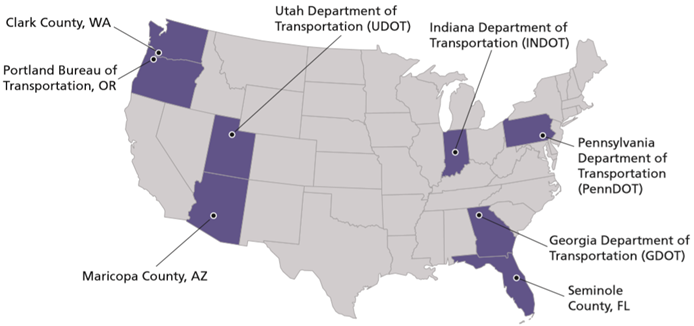Automated Traffic Signal Performance MeasuresCase Studies Source: FHWA
Source: FHWA
The Federal Highway Administration (FHWA) produced a series of case studies showcasing eight agencies from across the nation that successfully implemented automated traffic signal performance measures (ATSPM) approaches in their traffic signal operations programs. Care was taken to feature a range of agencies with differing program sizes—from small counties to large State departments of transportation. A diverse range of geographic locations was also included. Each case study was two-to-three pages in length and began with an infographic that featured the number of traffic signal program employees, traffic signals, miles of road operated by that agency, and the agency's annual traffic signal program budget. The graphic also presented the agency's traffic signal systems capability maturity self-assessment scores, allowing this information to be easily compared between case studies. The infographic allows the reader to quickly identify peer agencies in terms of program size and budget and be inspired by how peers utilized ATSPM to improve their traffic signal program. The case studies then provide more specific information about how ATSPM approaches were adopted by each agency and the benefits that were realized. Traffic Signal Systems Capability Maturity Self-Evaluation Tool: https://ops.fhwa.dot.gov/tsmoframeworktool/tool/tssc/  Map of the United States with participating agency states highlighted
Map of the United States with participating agency states highlighted
Source: FHWA CASE STUDY 1: Utah Department of Transportation (UDOT) – FHWA-HOP-18-048https://ops.fhwa.dot.gov/publications/fhwahop18048/index.htm  Photo Credit: UDOT "Signal performance measures have enabled the State of Utah to do more with less, focus our resources on the areas of most need, and to more effectively prioritize resources and workload."
Mark Taylor ATSPMs enable the Utah Department of Transportation (UDOT) to proactively manage traffic signal timing and quickly identify maintenance issues that affect traffic flow. UDOT's ATSPM program benefited from its partnership with Purdue University, FHWA, and the Transportation Pooled Fund Program. Today, UDOT's ATSPM contains a suite of data visualization reports that can be used to evaluate the quality of traffic progression along corridors and identify unused green time for allocation to other intersection movements. System reports of vehicle delay, volumes, and speeds can be used to evaluate the effectiveness of signal timing adjustments. ATSPM visualizations can also be used to inform UDOT staff of vehicle and pedestrian detector malfunctions, saving staff time during maintenance operations. ATSPM tools speed up decision-making and help UDOT staff prioritize operation and maintenance efforts. Since implementing its ATSPM program, UDOT has noted a significant drop in public complaints and requests for traffic signal retiming. The ATSPM system quickly identifies problems such as failed detectors and sends a simple email notification. These alerts allow UDOT to respond to issues before they become public nuisances and prolonged threats to mobility. UDOT is collecting ATSPM at 99 percent of its 1,271 traffic signals. Partner agencies have connected 90 percent of their 914 signals and report data through the same centralized operation. UDOT's end goal is to have all signals statewide connected and contributing data to their existing ATSPM system. To learn more, visit http://udottraffic.utah.gov/atspm/ CASE STUDY 2: Georgia Department of Transportation (GDOT) – FHWA-HOP-18-050https://ops.fhwa.dot.gov/publications/fhwahop18050/index.htm Photo Credit: GDOT
Photo Credit: GDOT
"Having eyes on the entirety of our large system has been pretty much impossible. But with the introduction of ATSPM, we have a snapshot of the health of our entire system and the ability to quickly diagnose and focus resources across the whole system."
Alan Davis  Photo Credit: GDOT
Photo Credit: GDOT
"With ATSPM, we can now aggregate information to a level where we understand how the system is actually behaving."
Sam Harris The Georgia Department of Transportation's (GDOT) ATSPM deployment uses the open-source ATSPM management software developed by the Utah Department of Transportation and features a public-facing website to make data and analysis readily available. Data collected by the ATSPM system allows GDOT to better manage the operations and maintenance of signals. GDOT's traffic engineers can use data visualizations from the ATSPM system to answer questions like:
GDOT also uses ATSPM data when developing alternate routing plans for events and emergencies. For example, ATSPM tools helped to develop alternate routes and adjust signal timing to address the 2017 I-85 bridge collapse in Atlanta. GDOT shares responsibility with local agencies for the operation of 6,500 of the State's 9,500 signals. GDOT has 6,775 signal connected on the ATSPM system that are logging high-resolution data. This number includes both GDOT signals and locally owned/operated signals. With over 59 percent of signals that GDOT owns or shares operational responsibilities reporting high-quality data, GDOT uses ATSPM as its primary tool to improve operations and manage maintenance. To learn more, visit https://traffic.dot.ga.gov/ATSPM/ CASE STUDY 3: Maricopa County, AZ – FHWA-HOP-18-052https://ops.fhwa.dot.gov/publications/fhwahop18052/index.htm Photo Credit: Maricopa Co. DOT
Photo Credit: Maricopa Co. DOT
"All the agencies involved are impressed that when a citizen complaint arrives, how quickly and easily this tool can help identify the severity of a traffic signal issue, and narrow into its root cause."
April Wire, PE, PTOE  Photo Credit: Maricopa Co. DOT
Photo Credit: Maricopa Co. DOT
"ATSPM is a helpful tool for getting funding support. Showing good data representations of performance, how specific investments can improve performance, is very convincing to nontechnical audiences."
Faisal Saleem The AZTech Regional Partnership implemented ATSPM in a regional context using Maricopa County's central ATSPM server. The ATSPM server is part of AZTech's Regional Archived Data System—a system that collects, processes, and archives intelligent transportation systems data from regional and local subsystems and 14 traffic management centers. Maricopa County's deployment approach leverages the existing Maricopa Association of Governments Regional Communication Network communication infrastructure, minimizing implementation costs and maximizing the availability of technology for agencies in the region. In 2016, Maricopa County launched its regional ATSPM pilot program with 70 signalized intersections (10 signals per jurisdiction). Today, the system integrates 273 signals equipped with high-resolution controllers. AZTech takes responsibility for the consolidation, analysis, and storage of data for its members' ATSPM systems. Maricopa County has led AZTech in the deployment of ATSPM systems, which are spread across eight jurisdictions. Maricopa County and AZTech used the open-source Utah Department of Transportation ATSPM monitoring software to manage information collected by the ATSPM system. The ATSPM server, which allows ATSPM data signals to communicate to the same server, is linked to AZTech's pooling data from various agencies in the region into one interface. The one-of-a-kind ATSPM system is the outcome of trust and working relationships that have formed and solidified over 22 years of AZTech Regional Partnership collaboration. Furthermore, the FHWA ATSPM Peer Exchange provided meaningful learning opportunities for AZTech Regional Partnership partners to gain knowledge about the system.
To learn more, visit
CASE STUDY 4: Clark County, Washington – FHWA-HOP-18-049https://ops.fhwa.dot.gov/publications/fhwahop18049/index.htm Photo Credit: Clark County
Photo Credit: Clark County
"So why are we doing ATSPMs? You can't improve if you don't measure."
Rob Klug, PE Clark County, Washington, has implemented ATSPM as part of its overarching Signal Timing, Evaluation, Verification, and Enhancement program. Clark County's ATSPM system objectives are:
Clark County's system is the outcome of a collaborative effort with Trafficware to develop an ATSPM module that stores and supports the evaluation of high-resolution data, Bluetooth® data, alarms and event logs, and other signal timing events to develop performance measures consistent with the traffic signal program's objectives. To reduce staff time spent analyzing data and improve the depth and breadth of traffic signal performance, Clark County is developing an ATSPM dashboard. The dashboard will help traffic engineers analyze data to determine how the transportation system is operating compared with recent traffic trends and performance metrics associated with individual corridors. The system will automatically flag current operations that are outside of accepted performance parameters. These checks are also monitored to determine if an occurrence is a one-time instance or an ongoing situation. Clark County has upgraded 100 percent of its 106 traffic signals to be ATSPM-capable. With upgraded controllers, the timing of these signals can be adjusted in real time based on data automatically collected. Additional Bluetooth data collection devices continue to be installed along major corridors to provide additional data to improve operation of the system. Clark County's ATSPM implementation benefited from proactive partnership and collaboration with the Southwest Washington Regional Transportation Council, the City of Vancouver, and the Washington State Department of Transportation. Volume and speed data collected at ATSPM-capable signals in Clark County are shared with the public through an online database, PORTAL, run by the Portland State University. New data analysis and reporting frameworks for ATSPM data will be developed in phase 2 of the project. To learn more, visit https://www.clark.wa.gov/public-works/traffic-signals CASE STUDY 5: Pennsylvania Department of Transportation (PennDOT) – FHWA-HOP-18-05https://ops.fhwa.dot.gov/publications/fhwahop18054/index.htmThe Pennsylvania Department of Transportation's (PennDOT) ATSPM program is statewide in scale. PennDOT has implemented ATSPMs where high-resolution controllers and field communications are available. PennDOT's overall ATSPM goals include:
PennDOT uses open-source software developed by the Utah Department of Transportation for data storage and reporting. Future ATSPM plans include enhancement of PennDOT's unified statewide command and control software platform. The platform is needed because PennDOT connects with approximately 1,200 different signal owners and six different system software types, many of which are not compatible with newer systems. PennDOT's unified command and control integrates wide-ranging ATSPM inputs all in one platform. PennDOT is supplementing ATSPM to meet its delay, safety, emissions, economic, system standardization, and collaboration goals with corridor-level probe data and performance management. Initial deployment of the probe data effort monitors 138 super-critical corridors and 2,184 traffic signals, and utilizes 776 arterial miles of INRIX data. Following initial deployment, PennDOT plans to expand implementation statewide and improve dashboard features. Probe data allows PennDOT to utilize the following tools:
To learn more, visit www.dot.state.pa.us/signals and https://signalmetrics.trafficwise.org/index.php CASE STUDY 6: Seminole County, FL – FHWA-HOP-18-056https://ops.fhwa.dot.gov/publications/fhwahop18056/index.htm Photo Credit: FDOT
Photo Credit: FDOT
"With increasing traffic and limited resources, ATSPM is a great tool to help us easily identify signal timing trouble spots and evaluate the operational efficiency of our corridors."
Charles R. Wetzel, P.E., PTOE Seminole County, Florida, uses ATSPM to support a wide range of performance metrics. Lane-by-lane detection, coupled with ATSPM systems, has reduced the need to perform periodic traffic counts and allowed for data-driven evaluations of signal performance. Using ATSPM to analyze before and after metrics for arrivals on red, arrivals on green, number of max outs, and number of gap outs allows Seminole County to immediately gauge performance improvements after a signal retiming effort. Likewise, the system enables Seminole County to evaluate the effectiveness of adaptive systems. System-generated Purdue Coordination Diagrams, together with comparisons of arrivals on green and red data, provide insights as to the effectiveness of an adaptive system. Seminole County's 387 signals are all recording high-resolution data. The ATSPM program began as a partnership with the Florida Department of Transportation (FDOT) and the Utah Department of Transportation (UDOT). Seminole County is also actively exploring ways to leverage ATSPM data to optimize operations at the corridor scale. Seminole County has devoted considerable resources to implementing ATSPMs on all its signals. Signal controllers were all upgraded to enable high-resolution data collection and the County laid a network of fiber optic cables to provide fast, reliable system communication. Data storage for ATSPMs has proven to be an important consideration for Seminole County. The County collects almost nine gigabytes of data daily, requiring considerable storage and communication capacity over time. Seminole County is using Trafficware 980 ATC controllers to enable ATSPMs on their signals. Seminole County originally used UDOT's ATSPM software to collect and display ATSPM data to the public but has since migrated their ATSPM website to FDOT's management so that other jurisdictions may also use the site as a common platform and one-stop website for Florida ATSPM data. The UDOT-developed software allows FDOT to bring ATSPM data from multiple jurisdictions across the state into one interface.  Photo Credit: FDOT
Photo Credit: FDOT
"Florida's statewide arterial management program considers various tools to help improve traffic signal operations. ATSPM is an important tool for accomplishing this goal."
Raj Ponnaluri, PhD, PE, PTOE, PMP Seminole County is just one of the local maintaining agencies that has partnered with FDOT on ATSPM deployment. Other implementations include: District 3 (City of Tallahassee): Initially installed at 22 signals on US 90. FDOT configured intersections and detector geometry along the corridor, allowing the relevant metric charts to be rendered. The City of Tallahassee has expanded ATSPM implementation to 40 more traffic signals. District 7 (D7): FDOT installed ATSPM along Fowler Avenue between I-275 and I-75.
To learn more, visit https://www.seminolecountyfl.gov/departments-services/public-works/traffic-engineering/ and https://atspm.cflsmartroads.com/ATSPM CASE STUDY 7: Indiana Department of Transportation (INDOT) - FHWA-HOP-18-051 Photo Credit: INDOT
Photo Credit: INDOT
"Our partnerships with the state and local agencies that were part of FHWA Transportation Pooled Fund Study TPF-5(258) were instrumental in developing consensus definitions that the industry could focus on to provide the required data collection capabilities."
Jim Sturdevant, PE The Indiana Department of Transportation (INDOT) pioneered the development of ATSPM and the application of ATSPM in real-world decision-making. INDOT piloted ATSPMs in 2003 and, by 2008, had implemented systemwide performance metrics supported by high-resolution data. INDOT led the Transportation Pooled Fund Program's Traffic Signal Systems and Operations and Management TPF-5(258) from 2013 to 2017. The study developed best practices for implementation of ATSPM systems and usage of the data collected. INDOT's ATSPM system is successfully used to evaluate signal retiming efforts, manage unplanned detour routes and diversions, and monitor programmatic performance measures. INDOT and Purdue University led research that serves as the basis for present day ATSPM programs across the country. In Performance Measures for Traffic Signal Systems: An OutcomeOriented Approach, the INDOT and Purdue University research team established a methodology for performance evaluation of traffic signal systems using high-resolution controller event data. INDOT and Purdue University share insights regarding collection and management of signal event data and the infrastructure needed to support ATSPM systems. Performance measures encompass system maintenance, asset management, multimodal signal operations, and assessing the impact of signal retiming activities. INDOT and Purdue University's Integrating Traffic Signal Performance Measures into Agency Business Processes outlines requirements for implementing data collection and processing into ATSPM programs. This publication uses example performance measures for communication and detector system health, capacity allocation, safety, pedestrian performance, preemption, advanced control analysis, and quality of progression. To learn more, visit https://www.in.gov/indot/3252.htm CASE STUDY 8: Portland Bureau of Transportation (PBOT) – FHWA-HOP-18-055https://ops.fhwa.dot.gov/publications/fhwahop18055/index.htm Photo Credit: PBOT
Photo Credit: PBOT
"We are getting data that enables us to look at the performance metrics… [but] detection is very critical. With detection you can get the data that you want. We are looking to be able to benefit from pedestrian delay and arrivals on green. We can look at performance measures from a central system and actually tell what is happening at those locations— 1,200 intersections are a lot for eight guys, so we don't have a lot of time to go take a look at things."
Willie Rotich, PE, ITS Engineer The Portland Bureau of Transportation (PBOT) is responsible for operation and maintenance of 1,200 traffic signals. To explore the benefit, value, and cost associated with implementation of an ATSPM system, PBOT initiated a pilot project at five intersections spread across the Portland. In the future, PBOT will expand the ATSPM system with detection at 30 additional signals along three identified corridors. Moving forward, PBOT has developed a prioritized list of intersections for the roll-out of controller upgrades and ATSPM installation in addition to the identified corridors. PBOT has also set the goal of developing a dashboard tool to combine ATSPM data with other data sources to improve operations and assist decision-making. While the ATSPM system in Portland is still in its infancy, there are ambitious plans for growth. The open-source ATSPM software developed by the Utah Department of Transportation was deployed by the Oregon Department of Transportation (Orgeon DOT) to collect data from all of the state's ATSPM-equipped signals. However, the Oregon DOT ATSPM site is behind a firewall and is not available to the public. Oregon's ATSPM systems use advanced detection including cameras and Bluetooth® readers. As PBOT incrementally upgrades signal controllers throughout Portland, detection hardware will need to be installed to enable ATSPM collection. PBOT has a strong multimodal focus and is very interested in using ATSPM data to measure pedestrian and bicyclist delay in addition to vehicle performance measures. A joint study between the Iowa State University, the Northern Arizona University, and the Portland State University, with cooperation from PBOT, explored the potential to deploy machine learning to refine the raw output data from ATSPM systems. The study used raw data from two of Portland's five ATSPM-equipped signals. Machine learning was used to filter out bad data, develop graphic representations of data, and intelligently learn patterns in demand over time. New performance metrics enabled by machine learning capabilities were dubbed Intelligent Traffic Signal Performance Measures (ITSPM). An example of ITSPMs enabled by machine learning is the Aggregate Platoon Coordination Diagram, which shows vehicle distributions in relation to signal timing using data collected over a day or week. To learn more, visit https://www.portlandoregon.gov/transportation/ |
|
United States Department of Transportation - Federal Highway Administration |
||